The National Structure of the Romanian Population at the 1st December 2021 Census
DOI:
https://doi.org/10.24193/subbgeogr.2025.1.03Keywords:
Romania, census, statistics, nationalities, territorial distributionAbstract
The National Structure of the Romanian Population at the 1st December 2021 Census. This study aims to focus on the spatial distribution of the 21 ethnic groups at the level of geographical-historical provinces and counties, based on the final results recorded at the Population and Housing Census of 1st December 2021. Compared to the total stable population of 19,053,815 inhabitants, the Romanian ethnic group has a percentage of 77.68%, followed at a great distance by the Hungarians (5.26%) and the Roma (3.00%), after which the other 18 ethnic groups (Ukrainians, Germans, Turks, Russian-Lipovans, Tatars, Serbs, Slovaks, Bulgarians, Croats, Greeks, Italians, Jews, Czechs, Poles, Ruthenians, Armenians, Albanians and Macedonians) all together represent only 0.92% of the total population. There is also the category Other ethnicity (Csangos, Gagauz, Chinese and other ethnicities from intra- and extra-community states) with 0.10%, as well as the category Unavailable information, which includes an important segment of the population of 13.04%.
References
1. Bodocan, V. (2001), Etnie, confesiune și comportament electoral în Transilvania. Studiu geografic, Edit. Presa Universitară Clujeană, Cluj-Napoca.
2. Cocean, P., Niță, A., Dombay, Șt. (2013), Județul Harghita, Edit. Academiei Române, București.
3. Crețan, R. (2006), Etnie, confesiune și opțiune electorală în Banat. Structuri teritoriale, tradiție, actualitate, Ediția a II-a, revăzută și adăugită, Edit. Universității de Vest, Timișoara.
4. Erdeli, G., Cucu, V. (2005), România. Populație. Așezări umane și economie, Edit. Transversal, București.
5. Giurescu, C., Giurescu, D., (1975), Istoria românilor 1, Edit. Științifică și Enciclopedică, București.
6. Gubani, I. (2016), The Slovak Minority in Romania. Historical Context and Statistical Aspect of Identity and Native Language Within the Period of 2002-2011, Geograficke Informacie, vol. 20, No. 2, 420-451.
7. Ilieș, Al. (1998), Etnie, confesiune și comportament electoral în Crișana și Maramureș. Studiu geografic (sfârșitul sec. XIX și sec. XX), Edit. Dacia, Cluj-Napoca.
8. Ilinca, N. (1999), Geografie Umană. Populația și așezările omenești, Edit. Corint, București.
9. Netedu, A. (2012), The Measurement of Population and Sourses of Erorr the 2011 Census in Romania, European Journal of Science and Theology, Vol. 8, No. 3, 83-89.
10. Nimigeanu, V. (1996), România. Geografie Umană, Edit. Universității „Alexandru Ioan Cuza”, Iași.
11. Pop, Gr. (1986), România. Geografie economică, Partea I, Universitatea din Cluj-Napoca.
12. Pop, P. Gr. (1991), The National Structure of Romania’s Population, Studia UBB Geographia, 35 (2), 3-15.
13. Pop, P. Gr. (2004), Structura etnică a populației României, în anul 2002, Revista Română de Geografie Politică, 6 (1-2), 17-34.
14. Pop, P. Gr., Rusu, R. (2014), The National Structure of the Romanian Population at the 20th of October 2011 Census, Studia UBB, Geograhia, 59 (1), 5-26.
15. Pop, P. Gr., Niță, A. (2015), The Szeklers and Hungarians from Romania, Studia UBB, Geographia 59 (2), 53-68.
16. Rotariu, Tr., Dumănescu, Luminița, Hărăguș, Mihaela (2017), Demografia României în perioada postbelică (1948-2015), Edit. Polirom, Iași.
17. Tofan, G. B. (2014a), The Ethnic and Confessional Structure of Harghita County în 2011, Annals of the University of Bucharest, Geography Series, 63, 83-92.
18. Tofan, G. B. (2014b), The Ethnic and Confessional Structure of Mureș County în 2011, Annals of the University of Oradea, Geography Series, 24 (1), 14-22.
19. Tofan, G. B. (2015), Etnie, confesiune și comportament electoral în județele Harghita, Covasna și Mureș. Studiu geografic (2008-2014), Edit. Casa Cărții de Știință, Cluj-Napoca.
20. Vert, C. (2001), Geografia populației. Teorie și metodologie, Edit. Mirton, Timișoara.
21. *** (1984), Geografia României II. Geografia Umană și Economică, Edit. Academiei R. P. R. București.
22. *** (2024), Institutul Național de Statistică, Recensământul populației și locuințelor, 2021. Bucharest. Available online: https://www.recensamantromania.ro/rezultate-rpl-2021/rezultate-definitive/ (last accessed on February 19, 2024).
Downloads
Published
How to Cite
Issue
Section
License
Copyright (c) 2025 Studia Universitatis Babeș-Bolyai Geographia

This work is licensed under a Creative Commons Attribution-NonCommercial-NoDerivatives 4.0 International License.


 ©Studia Universitatis Babeş-Bolyai Geographia. Published by Babeș-Bolyai University.
©Studia Universitatis Babeş-Bolyai Geographia. Published by Babeș-Bolyai University.